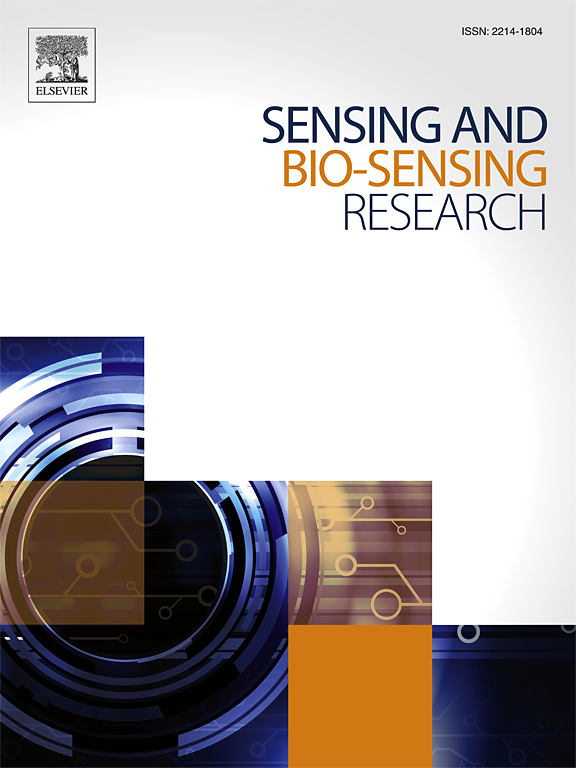Highly efficient assessment and selective determination of pancreatic cancer biomarker CA-19-9 using co-electrodeposited MXene-AgNPs nanocomposite
IF 5.4
Q1 CHEMISTRY, ANALYTICAL
引用次数: 0
Abstract
An ultrasensitive and label-free electrochemical immunosensor based on MXene-AgNPs nanocomposite is reported for pancreas cancer diagnostics. Ease of deposition, high speed, thickness of deposition and high efficiency of these biosensors are their special and fundamental advantages.
For this purpose, a pencil graphite electrode (PGE) was modified by silver and MXene (Ti3C2Tx (to increase efficiency and also the active surface area of PGE. Deposition of AgNPs-MXene nanocomposite then immobilization of streptavidin and biotinylated antibody on the electrode increases the sensitivity, conductivity and stability of the designed immunosensor. The electrochemical measurements in the attendance and absence of AgNPs-MXene can causing an increase in electrical currents. To examine the morphology of the developed immunosensor for the purpose of enhancing its optimal performance, the characterization methods employed include Field Emission Scanning Electron Microscopy (FE-SEM), Fourier-Transform Infrared Spectroscopy (FT-IR), and X-ray Diffraction (XRD). The results of the studies projected antibody (Ab) CA-19-9/AgNPs-MXene electrochemical immunosensor as a potential and affordable alternate of conventional methods like ELISA. The desirable LOD was recorded as 1 nU/mL. The repeatability and reproducibility were successfully inspected for ten repeated mensuration and the lowest RSD percentages were observed as about 5 % for the concentration of 1, 10 and 20 nU/mL. As a proof of the discussed results, the presented biosensor has a high sufficiency to be used in clinical laboratories to diagnose pancreatic cancer. We believe that our fabricated sensor can be the plan of diseases management program due to affordable rapid and label free detection of a targeted biomarkers.
利用共电沉积MXene-AgNPs纳米复合材料高效评估和选择性测定胰腺癌生物标志物CA-19-9
报道了一种基于MXene-AgNPs纳米复合材料的超灵敏无标记电化学免疫传感器用于胰腺癌诊断。沉积容易、沉积速度快、沉积厚度大、效率高是这些生物传感器独特而又根本的优点。为此,用银和MXene (Ti3C2Tx)修饰铅笔石墨电极(PGE),以提高其效率和活性表面积。在电极上沉积AgNPs-MXene纳米复合材料,然后将链霉亲和素和生物素化抗体固定在电极上,提高了所设计的免疫传感器的灵敏度、导电性和稳定性。在AgNPs-MXene存在和不存在的情况下,电化学测量会引起电流的增加。为了研究所开发的免疫传感器的形貌以提高其最佳性能,采用了场发射扫描电镜(FE-SEM)、傅里叶变换红外光谱(FT-IR)和x射线衍射(XRD)等表征方法。研究结果预测抗体(Ab) CA-19-9/AgNPs-MXene电化学免疫传感器是ELISA等传统方法的潜在且经济实惠的替代方法。记录所需LOD为1 nU/mL。在1、10和20 nU/mL浓度下,成功地进行了10次重复测定,重复性和再现性最低,RSD百分比约为5%。作为讨论结果的证明,所提出的生物传感器具有很高的充分性,可用于临床实验室诊断胰腺癌。我们相信,由于我们制造的传感器可以负担得起的快速和无标签的检测目标生物标志物,因此可以成为疾病管理计划的计划。
本文章由计算机程序翻译,如有差异,请以英文原文为准。
求助全文
约1分钟内获得全文
求助全文
来源期刊

Sensing and Bio-Sensing Research
Engineering-Electrical and Electronic Engineering
CiteScore
10.70
自引率
3.80%
发文量
68
审稿时长
87 days
期刊介绍:
Sensing and Bio-Sensing Research is an open access journal dedicated to the research, design, development, and application of bio-sensing and sensing technologies. The editors will accept research papers, reviews, field trials, and validation studies that are of significant relevance. These submissions should describe new concepts, enhance understanding of the field, or offer insights into the practical application, manufacturing, and commercialization of bio-sensing and sensing technologies.
The journal covers a wide range of topics, including sensing principles and mechanisms, new materials development for transducers and recognition components, fabrication technology, and various types of sensors such as optical, electrochemical, mass-sensitive, gas, biosensors, and more. It also includes environmental, process control, and biomedical applications, signal processing, chemometrics, optoelectronic, mechanical, thermal, and magnetic sensors, as well as interface electronics. Additionally, it covers sensor systems and applications, µTAS (Micro Total Analysis Systems), development of solid-state devices for transducing physical signals, and analytical devices incorporating biological materials.
 求助内容:
求助内容: 应助结果提醒方式:
应助结果提醒方式:


